Planet Mars | Diameter 138 km | |
 | ||
Eponym Theophile Moreux, a French astronomer and meteorologist (1867-1954) | ||
Moreux Crater is a crater in the Ismenius Lacus quadrangle on Mars with a diameter of 138 km. It is located at 42.1° north latitude and 315.6° west longitude It was named after Theophile Moreux, a French astronomer and meteorologist (1867–1954).
Contents
Glaciers
Moreux Crater's appearance has been shaped by the action of glaciers. Recent research, using a variety of images from various cameras, discovered extensive glacial modification of the surfaces of Moreux Crater's rim, wall, and central peak. These changes were caused by the emplacement of ice-rich material when the climate underwent major changes.
Glaciers modified large areas of the surface of Mars. Many places are believed to still contain enormous amounts of water ice that was associated with glaciers. Many craters contain large amounts of ice. If one measures the diameter of a crater, the original depth can be estimated with various ratios. Because of this relationship, researchers have found that many Martian craters contain a great deal of material; much of it is believed to be ice deposited when the climate was different. Glaciers have shaped much of the fretted terrain. It would be difficult to take a hike on the fretted terrain because the surface is folded, pitted, and often covered with linear striations. The striations show the direction of movement. Much of this rough texture is due to sublimation of buried ice. When the ice transitions directly into a gas it leaves behind an empty space. Overlying material then collapses into the void. Glaciers are not pure ice; they contain dirt and rocks. At times, they will dump their load of materials into ridges. Such ridges are called moraines. Some places on Mars have groups of ridges that are twisted around; this may have been due to more movement after the ridges were put into place. Sometimes chunks of ice fall from the glacier and get buried in the land surface. When they melt and more or less round hole remains. On Earth we call these features kettles or kettle holes. Mendon Ponds Park in upstate NY has preserved several of these kettles. The picture from HiRISE below shows possible kettles in Moreux Crater.
Impact craters generally have a rim with ejecta around them, in contrast volcanic craters usually do not have a rim or ejecta deposits. As craters get larger (greater than 10 km in diameter) they usually have a central peak. The peak is caused by a rebound of the crater floor following the impact. Sometimes craters expose layers that were buried. Rocks from deep underground are tossed onto the surface. Hence, craters can show us what lies deep under the surface.
Why are Craters important?
The density of impact craters is used to determine the surface ages of Mars and other solar system bodies. The older the surface, the more craters present. Crater shapes can reveal the presence of ground ice.
The area around craters may be rich in minerals. On Mars, heat from the impact melts ice in the ground. Water from the melting ice dissolves minerals, and then deposits them in cracks or faults that were produced with the impact. This process, called Hydrothermal Alteration, is a major way in which ore deposits are produced. The area around Martian craters may be rich in useful ores for the future colonization of Mars. Studies on the earth have documented that cracks are produced and that secondary minerals veins are deposited in the cracks. Images from satellites orbiting Mars have detected cracks near impact craters. Great amounts of heat are produced during impacts. The area around a large impact may take hundreds of thousands of years to cool. Many craters once contained lakes. Because some crater floors show deltas, we know that water had to be present for some time. Dozens of deltas have been spotted on Mars. Deltas form when sediment is washed in from a stream entering a quiet body of water. It takes a bit of time to form a delta, so the presence of a delta is exciting; it means water was there for a time, maybe for many years. Primitive organisms may have developed in such lakes; hence, some craters may be prime targets for the search for evidence of life on the Red Planet.
